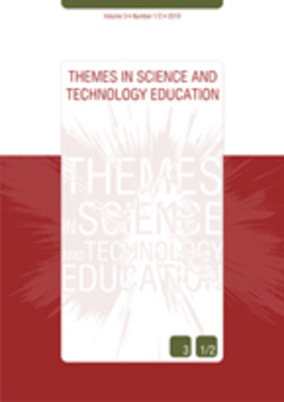Educational robotics as mindtools
Part of : Themes in science and technology education ; Vol.6, No.1, 2013, pages 5-14
Issue:
Pages:
5-14
Abstract:
Although there are many studies on the constructionist use of educational robotics, they have certain limitations. Some of them refer to robotics education, rather than educational robotics. Others follow a constructionist approach, but give emphasis only to design skills, creativity and collaboration. Some studies use robotics as an educational tool in engineering education, science and programming learning implying mindtools, but they do not give evidence of mindtool characteristics. This work proposes educational robotics as mindtools based on constructivism and especially constructionism. The positive learning results from two case studies on physics and programming teaching indicate that educational robotics can be used as mindtools supporting knowledge construction through the design of meaningful authentic projects, learning by doing in both the virtual and real world, facing cognitive conflicts and learning by reflection and collaboration.
Subject:
Subject (LC):
Keywords:
educational robotics, mindtools, physics, programming
Notes:
This article is a memorandum to our inspirer and friend David H. Jonassen
References (1):
- Alimisis, D., Karatrantou, A., & Tachos, N. (2005). Technical school students design and develop robotic gear- based constructions for the transmission of motion. In S. Correia & A. Walat (eds.), Proceedings of Eurologo 2005 pp. (pp. 76-86). Warsaw.Barreto, F., & Benitti, V. (2012). Exploring the educational potential of robotics in schools: A systematic review. Computers & Education, 58, 978-988.Barker, B. S., Nuget, G., & Grandgenett, N. (2008). Examining 4-H robotics and geospatial technologies in the learning. Journal of Extension, 46(3). Retrieved 20 March 2013, from http://www.joe.org/joe/2008june/rb7.php.Bers, U. M., Ponte, I., Juelich, C., Viera, A., & Schenker, J. (2002). Teachers as designers: integrating robotics in early childhood education. Information Technology in Childhood Education Annual, 14, 123-145.Cavas, B., Kesercioglu, T., Holbrook, J., Rannikmae, M., Ozdogru, E., & Gokler, F. (2012). The effects of robotics club on the students’ performance on science process & scientific creativity skills and perceptions on robots, human and society. In D. Alimisis & M. Moro (eds.), Proceedings of 3rd International Workshop Teaching Robotics, Teaching with Robotics Integrating Robotics in School Curriculum (pp. 40-50) Trento, Italy. Retrieved 20 March 2013, from http://www.terecop.eu/TRTWR2012/trtwr2012_submission_20.pdf.Chambers, J. M., & Carbonaro, M. (2003). Designing, developing, and implementing a course on LEGO robotics for technology teacher education. Journal of Technology and Teacher Education, 11(2), 209-241.Dagdilelis, V., Sartatzemi, M., & Kagani, K. (2005). Teaching (with) robots in secondary schools: some new and not-so-new pedagogical problems. In P. Goodyear. D. G. Sampson, D. J. Yang, Kinshuk, T. Okamoto, R. Hartley, & N. Chen (eds.), Proceedings of the Fifth IEEE International Conference on Advanced Learning Technologies (ICALT’05) (pp. 757-761) CA: IEEE Computer Society.Datteri, E., Zecca, L., Laudisa, F., & Castiglioni, M. (2012). Explaining robotic behaviors: a case study on science education. In D. Alimisis & M. Moro (eds.), Proceedings of 3rd International Workshop Teaching Robotics, Teaching with Robotics Integrating Robotics in School Curriculum (pp. 134-143) Trento, Italy. Retrieved 20 March 2013, from http://www.terecop.eu/TRTWR2012/trtwr2012_submission_20.pdf.Denis, B., & Hubert, S. (2001). Collaborative learning in an educational robotics environment. Computers in Human Behavior, 17, 465–480.Erwin, B., Cyr, M., & Rogers, C. (2000). LEGO engineer and RoboLab: Teaching engineering with LabVIEW from kindergarten to graduate school. International Journal of Engineering Education, 16(3), 181-192.Goff, R. M., & Vernon, M. R. (2001). Using LEGO RCX bricks as the platform for interdisciplinary design projects. In Proceedings of the 2001 American Society for Engineering Education Annual Conference & Exposition. Retrieved 20 March 2013, from http://succeednow.org/papers/01/01096.pdf.Hacker, L. (2003). Robotics in education: ROBOLAB and robotic technology as tools for learning science and engineering. Unpublished Senior Thesis Department of Child Development, Tufts University. Retrieved 20 March 2013, from http://ase.tufts.edu/roboticsacademy/Theses/LauraHacker03.pdf.Isela, M., & Mota, G. (2007). Work in progress - using Lego mindstorms and Robolab as a mean to lowering dropout and failure rate in programming course. In Proceedings of the 37th annual frontiers in education conference - global engineering: knowledge without borders, opportunities without passports, 2007 FIE '07. Retrieved 20 March 2013, from http://fie.engrng.pitt.edu/fie2007/papers/1594.pdfJonassen, D. H. (2000). Computers as mindtools for schools. NJ: Prentice Hall.Mikropoulos, T. A., & Bellou, J. (2006). The Unique Features of Educational Virtual Environments, in P. Isaias, M.McPherson & F. Banister (eds.), Proceedings e-society 2006, International Association for Development of theInformation Society (v.1, pp. 122-128) IADIS.Nuget, G., Barker, B., Grandgenett, N., & Adamchuk, V. (2009). The Use of digital manipulatives in K-12: robotics, GPS/GIS and programming. In C. Atman (ed.). Proceedings of the 39th IEEE international conference on Frontiers in education conference (pp. 302-307) San Antonio Texas: IEEE Press. Retrieved 20 March 2013, from http://fie2012.org/sites/fie2012.org/history/fie2009/papers/1041.pdf.Papanikolaou, K., & Frangou, S. (2009). Robotics as Learning Tool. In D. Alimisis (ed.), Teacher education on Robotics-enhanced constructivist pedagogical models (pp. 103-137), Athens: School of Pedagogical andTechnological Education (ASPETE). Retrieved 20 March 2013, from http://dide.ilei.sch.gr/keplinet/education/docs/book_TeacherEducationOnRobotics-ASPETE.pdf.Papert, S. (1993). The Children’s Machine. New York: Basic Books.Resnick, M., & Silverman, B. (2005). Some reflections on designing construction kits for kids. In Proceedings of the Interaction Design and Children conference. Boulder, CO. Retrieved 20 March 2013, from http://llk.media.mit.edu/papers/IDC-2005.pdf.Ringwood, J. V., Monaghan, K., & Maloco, J. (2005). Teaching engineering design through Lego Mindstorms. European Journal of Engineering Education, 30(1), 91-104.Sullivan, F. R. (2008). Robotics and science literacy: thinking skills, science process skills and systems understanding. Journal of Research in Science Teaching, 45(3), 373–394.Staszowski, K. J., & Bers, M. (2005). The effects of peer interactions on the development of technological fluency in an early-childhood, robotic learning environment. In Proceedings of the 2005 American Society of Engineering Education Annual Conference & Exposition. Retrieved 20 March 2013, from http://ase.tufts.edu/devtech/publications/ASEE2005.pdf.Thornton, R. K. (1999). Using the results of research in science education to improve science learning. In Proceedings of the International Conference on Science Education. Nicosia, Cyprus. Retrieved 20 March 2013, from http://probesight.concord.org/what/articles/thornton.pdf.Wang, E. (2001). Teaching freshmen design, creativity and programming with LEGOs and LABVIEW. In Proceedings of the ASEE/IEEE Frontiers in Education Conference. Retrieved 20 March 2013, from http://fie.engrng.pitt.edu/fie2001/papers/1291.pdf.




